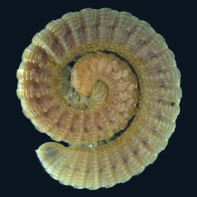Myriapoda collection

Chiraziulus troglopersicus Reboleira, Malek Hosseini, Sadeghi & Enghoff, 2015, paratype. One of the more than 300 millipede species of which the primary type is in the museum’s collection.
(S. Reboleira)
Curator
Collection managers
Anders Illum, Jan Pedersen & Sree Selvantharan
About the collection
Apart from old types of F. Meinert (mostly Chilopoda) and H.J. Hansen (Symphyla and Pauropoda), the collections are mainly of recent date.
There is a separate Danish collection and a global general collection, the latter focused on, but not limited to ‘The Old World’.
List of primary types in the collection, as well as complete lists of species of Diplopoda and Symphyla in the collection, can be in the 'Links' column to the right.
Taxonomical coverage
Approximately 2,000 out of 14,000 described species.
Myriapoda collection in numbers
- Estimated number of specimens/collections: not counted, estimated ~20,000 lots
- Types:
- 322 primary types of Diplopoda (Akkari, Demange, Enghoff, Frederiksen, Golovatch, Hoffman, Mauriès, Meinert, Read, Reboleira, Schiøtz, Silvestri etc.)
- 16 of Pauropoda (Hansen)
- 129 of Symphyla (Hansen)
- 109 of Chilopoda (Meinert, Eason a.o.)
- Digitally available specimens: primary types, few others
- Percentage digitized: low
Strengths
- Diplopoda from West and East Africa, particularly Tanzania (coll. V. Schiötz, N. Scharff etc.)
- Diplopoda from Thailand (coll. B. Degerbøl etc.)
- Palaearctic Diplopoda, esp. order Julida
- Diplopoda and Chilopoda from Denmark (many collectors), Madeira (H. Enghoff etc.) and the Canary Islands (H. Enghoff etc.)
- Millipedes infected with identified and unidentified Laboulbeniales fungi
History
A small part of the collection dates back to the 1800’s (mainly Meinert, Hansen). From 1900-1975 notable additions were made by mainly S. Gisle Larsson (Danish material), the Noona Dan Expedition (Philippine, Bismarck and Solomon Islands), V. Schiøtz (tropical Africa) and B. Degerbøl (Thailand).
Since 1975 the collection of Chilopoda and especially Diplopoda has been given considerable curatorial attention, and very important supplements have been provided by several staff and students collecting mainly in Australia, New Zealand, Thailand, Tanzania, Madeira, the Canary Islands, and Denmark, and considerable additions to the Diplopoda have been obtained by donations and exchange, including large samples from Tanzania donated by the NGO Frontier Tanzania.
